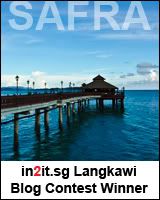Structures materializing from nothingness, a flower unfolding its petals through the night, a butterfly’s metamorphosis from pupa to adult stage, the sky changing its hues while the sun rises and sets… where it is not feasible to run a video camera for a long period of time to capture these defining moments, there’s time-lapse photography.
I’ve always found this photographic technique fascinating for the photo-video it produces but have never found the motivation to try it until a stay at the beautiful Gaya Island Resort. Located on Pulau Gaya, the largest of 5 islets sitting off the northwestern coast of Kota Kinabalu City, the resort’s hillside villas offer a jaw-dropping view overlooking the South China Sea with the horizon rimmed by Kinabalu’s mountainous range. This awe-inspiring setting was the perfect muse to coax my first attempt at time-lapse photography because I wanted my first time to be special!
In this post, I’ll share my experience and tips on time-lapsing a sunrise in the hope that the information will be useful for anyone attempting this technique for the first time.
Equipment and Necessities :
– DSLR camera (ensure that your battery is fully charged)
– Tripod
– Cable release or remote control
– Torch light, drinking water, towel and insect repellent (if photographing close to nature)
Time-lapse photography involves 2 steps… The first step is acquiring the images and the second step is combining the photos to form a video clip.
Step 1 : Acquiring the Images
Before embarking on a time-lapse photography session, always find out what time is sunrise at the locale you are shooting and be there an hour early to recce, set up equipment and frame the shot. In Singapore, I am used to daybreak happening at around 6.15am but at Kota Kinabalu, the sky starts brightening from 5.30am!

4:30am. It’s pitch black during the wee hours so a torchlight is essential for knowing you are putting all the parts in the right places.

As it was very dark, it was hard to frame the scene and get the horizon straight. I used the city lights in the distance to gauge and frame my shot.
Camera Settings :
– Switch the camera’s lens focus to Manual and set it to infinity
– Use Aperture (‘A’) mode for the shoot and set F-number to 16 (F16)
– Set ISO to the minimal (the lowest for my DSLR is 200)
– Turn on remote control shooting mode (if you use a cable release to control your shutter, this step is not necessary)
– Switch on your patience if your DSLR doesn’t come with a built-in interval timer like Nikon D7000 (I’m using Nikon D90 so I stood by my camera the whole time to click the remote control to shoot)

My time-lapse photos were taken from Gaya Island Resort’s Kinabalu Villa number 852 from 5:00am to 7:00am.

5:41am. Witnessing the arrival of dawn is truly magical. The highest peak in the distance is Mount Kinabalu. Awesome!

Pano view of the scene in front of me at daybreak.
Timing the Time-Lapse Intervals
Math and I are eternal enemies so my mind went into screensaver mode the instant I tried understanding how to calculate my number of shots. Basically, you have to first determine how long you want your time-lapse video to be and decide on how many shots you want per second of your video.
For example, if I want a 10-second video with 24 photos per second, I’ll have to shoot 240 images. Shooting from 5 – 7am (7,200 seconds), the interval between my shots would be 30 seconds. Which means I’ll take 1 photo and 30 seconds later, take another. The shots continue until I reach 240 shots.
That’s a lot of calculating to do!
So I simplify. I just made it a point to take a shot every 15 seconds from 5-7am. It didn’t matter how many photos I got, I just combined them all into the time-lapse video. I wasn’t concerned with how long the video lasted either. I ended up with about 365 shots and a sunrise segment that lasted 38 seconds on the video at the end of this post.

6:17am. The fiery disc popped out from the mountainous horizon.

I had it easy with this time-lapse shoot as the location was at the balcony of our villa. During the 2-hour shooting process, a Macaque Monkey came to visit and 2 Oriental Piped Hornbills flew by while countless birds serenaded the dawn. The entire experience was pure magic!

Such a sense of accomplishment for not sleeping in and miss the rare opportunity to time-lapse this incredibly scenic sunrise.
Step 2 : Creating a Time-Lapse Video
After capturing all the images, the next challenge is to combine them all into a video. There are quite a few options with Lightroom providing a pain-free way to do the job, but since I don’t have that program, I went with Photoshop to batch process the photos for a lower resolution and Windows Movie Maker to string the shots into a video.
It is necessary to batch process the photos first to shrink their file sizes before importing them into Windows Movie Maker to cut down on processing time. In Windows Movie Maker, I set the animation duration between photos to 0.07 seconds, add in a title, music, ending message and voila! I have my first time-lapse video! Hope you’ll enjoy it…











May 08, 2013 @ 10:02:44
I would love to take a photography class with you as I am sure you help everyone understand each step.
May each of your first times be outstanding.
May 08, 2013 @ 16:17:32
thanks scot 🙂 just sharing what I learnt from others and notes from my own experience.
May 24, 2013 @ 22:50:56
Not sure how I didn’t see this post earlier, but it’s absolutely amazing! You have inspired me to try this…sometime. Need a subject first, and a tripod, and a remote control…it’ll happen eventually 😛
May 29, 2013 @ 03:17:46
thanks for reading 🙂 hope ur wish list get fulfilled to try time-lapse photography. actually, u don’t need a tripod. any flat surface to place ur camera on will do and any subject would be interesting since it’s observing their changes through time. but u do need a remote control. look forward to seeing ur foray into time-lapse! 🙂